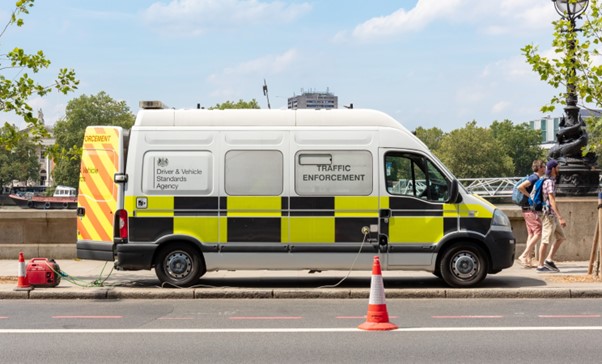
Susie Jones
Пояснення щодо перевірок DVSA для вантажівок
Створено: 08.08.2024
•
Оновлено: 08.08.2024
Під час вашої кар'єри водія вантажівки вас може зупинити Агентство стандартів для водіїв і транспортних засобів (DVSA). Для водіїв-новачків у цій галузі це може бути складним процесом. Однак розуміння основних аспектів перевірок вантажівок DVSA може зробити цей процес менш стресовим.
Хто такий DVSA?
Згідно з [Gov.uk] (http://gov.uk/), DVSA відповідає за "проведення придорожніх перевірок комерційних водіїв та транспортних засобів, щоб переконатися, що вони дотримуються правил безпеки та підтримують транспортний засіб у безпечному стані".
DVSA може проводити вибіркові перевірки вашої вантажівки та видавати заборони. Заборони не дозволяють водієві вантажівки керувати транспортним засобом до вирішення проблеми з його транспортним засобом.
Поліція також має право зупиняти водіїв вантажівок і проводити аналогічні перевірки.
Як виглядають екзаменатори DVSA?
Існує кілька способів ідентифікувати екзаменатора DVSA. Вони носять жовті жилети з логотипом DVSA і завжди мають при собі посвідчення. Їхні автомобілі мають чорно-жовтий принт з логотипом DVSA на капоті.

Що станеться, якщо вас зупинять?
Відмова зупинитися на вимогу інспектора DVSA є правопорушенням. Якщо інспектор попросить вас зупинитися, він проведе перевірку на узбіччі або на спеціальному майданчику. Основна мета таких зупинок - не допустити небезпечні транспортні засоби на дорогу.
Екзаменатор виконує наступні обов'язкові перевірки:
Перевірка дозволеної ваги вантажу та типу вантажу
Перевірка на механічні несправності та придатність до експлуатації
Забезпечення коректності записів вашого тахографа
Переконайтеся, що у вас є дійсне водійське посвідчення.
Скільки часу триває перевірка DVSA?
В середньому, перевірка DVSA займає 15 хвилин. Однак у випадках, коли вантажівка не відповідає вимогам безпеки, це може зайняти більше часу. Екзаменатор повинен провести необхідні перевірки незалежно від часу.
Як переконатися, що ваш транспортний засіб придатний до експлуатації
Водій несе відповідальність за те, щоб його вантажівка була придатна до експлуатації. Перед кожною поїздкою рекомендується проводити об'їзну перевірку.
Перевірте наступні пункти:
Світло
Індикатори
Паливо та мастила
Шини
Кріплення для коліс
Кузовні роботи
Зчіпка для причепа
Вантаж та інше обладнання
Перевірки в кабіні автомобіля (наприклад, ремені безпеки, звуковий сигнал, двірники, омивачі, рульове управління та індикатор висоти).
Крім того, водій вантажівки зобов'язаний письмово повідомляти свою організацію про будь-які дефекти. Вони повинні включати в себе наступне:
Реєстраційний або ідентифікаційний знак транспортного засобу
Дата перевірки
Деталі дефектів
Ім'я особи, яка повідомляє про дефекти.
Обов'язки оператора
Оператори транспортних засобів несуть відповідальність за забезпечення безпеки своїх транспортних засобів і повинні виконувати наступні дії:
Оператор повинен забезпечити проведення регулярних перевірок безпеки для всіх комерційних транспортних засобів
Вони повинні переконатися, що їхні водії розуміють, які перевірки мають відбуватися.
Заборони на дорогах
Якщо ваша вантажівка не придатна до експлуатації, DVSA може видати вам два різних повідомлення про заборону - негайну або відстрочену.
Негайне повідомлення про заборону:
Він може набути чинності негайно
У більшості випадків це призведе до знерухомлення транспортного засобу
Негайні заборони можуть призвести до судового переслідування.
Запізніле повідомлення про заборону:
Оператор має до 10 днів на вирішення проблем
Через десять днів офіцери проведуть повторний огляд транспортного засобу
Заборони повинні бути зняті до того, як вантажівка зможе почати рух.
Заборони щодо придатності до експлуатації
Якщо вантажівка має механічні проблеми або кузов і обладнання не відповідають стандартам, водій отримує заборону на допуск до дорожнього руху. Для транспортних засобів за межами Великобританії водій отримає негайну заборону. Для британських операторів тип заборони буде залежати від того, наскільки серйозним є дефект.
Незначні дефекти:
Незначні дефекти можуть призвести до відкладеної заборони
Оператор матиме до десяти днів на усунення будь-яких недоліків
Повторний огляд відбудеться через десять днів.
Серйозні дефекти:
Водій отримає заборону з позначкою "S" за серйозний дефект
Заборона з позначкою "S" з'являється, коли виникає проблема з технічним обслуговуванням
Якщо експерт вирішить, що безпосереднього ризику немає, то заборони можуть бути відкладені
Транспортний засіб буде заблоковано, а вам загрожує кримінальна відповідальність.
Заборона з позначкою "S" не з'явиться для наступних дій:
Якщо під час подорожі виникла проблема
Проблему не вдалося виявити (наприклад, дефект на нижній стороні).

Заборона перевантаження
Якщо транспортний засіб перевантажений, інспектор DVSA може знерухомити його. Крім того, інспектор може спрямувати вантажівку до найближчого місця, де вантаж може бути перерозподілений або знятий. Оператор транспортного засобу отримає відповідне повідомлення.
Заборони щодо водійських годин
Водії, які не дотримуються правил використання тахографа і водійських годин, отримують заборону. Це може призвести до штрафу, судового переслідування, або ж транспортний засіб може бути заблокований.
Дізнайтеся більше про [правила та положення щодо тахографів] (https://https://snapacc.com/newsroom/tachograph-rules-made-easy/)
Хоча іспити DVSA можуть бути страшною перспективою для водіїв вантажівок, це, безперечно, позитивний фактор для безпеки дорожнього руху. Переконайтеся, що ви пройшли всі необхідні перевірки та дотримуєтеся основних правил і норм, і іспит DVSA пройде гладко.
Як довго ви повинні зберігати дефектні листи вантажівок?
Впровадження системи нульової звітності про дефекти може стати вашою першою лінією захисту при демонстрації того, що ваші транспортні засоби перебувають у придатному для експлуатації стані. Роботи з усунення дефектів повинні бути зареєстровані та зберігатися протягом 15 місяців. Якщо дефектів немає, компанія повинна вести записи, щоб гарантувати, що водії здійснюють свої перевірки.
Як часто вам потрібен медичний огляд, щоб зберегти ліцензію?
Щоб отримати та утримувати ліцензію на керування вантажними автомобілями, обов'язково потрібно пройти медичний огляд - без цього вам не видадуть ліцензію.
Для водіїв молодше 45 років медичний огляд триває до 45-річчя. Однак після цього віку ви будете зобов'язані проходити медичний огляд кожні п'ять років до досягнення 65-річного віку. Водії 65 років і старше зобов'язані проходити медичний огляд щороку.



